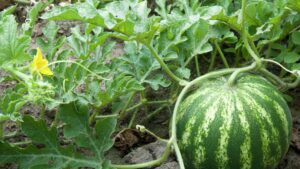What to do with watermelon rind? This versatile fruit’s often-discarded rind holds a treasure trove of culinary delights, creative wonders, and eco-friendly applications, inviting us to embrace sustainability and unleash our imaginations.
From tantalizing salads to refreshing soups and delectable desserts, the culinary possibilities of watermelon rind are endless. Its unique texture and subtle sweetness lend themselves to a range of culinary adventures, transforming this humble byproduct into a star ingredient.
Culinary Delights
Beyond its juicy flesh, the watermelon rind holds a treasure trove of culinary potential. With its mild, refreshing flavor and crispy texture, it can be transformed into a variety of delectable dishes.
The succulent flesh of a watermelon is a summer delight, but don’t discard the rind just yet. It’s a treasure trove of nutrients and culinary potential. If you’re wondering how long your watermelon will last, you can find a comprehensive guide here . Back to the rind, it can be transformed into refreshing pickles, tangy salads, or even a crunchy stir-fry, adding a burst of freshness and nourishment to your meals.
The rind is typically removed and discarded, but it can be easily repurposed to create salads, soups, and even desserts. Here are some innovative ideas to incorporate watermelon rind into your culinary repertoire:
Salads
- Watermelon Rind Salad: Slice the rind into thin strips and toss with fresh mint, feta cheese, and a drizzle of olive oil and lemon juice for a refreshing and light salad.
- Watermelon Rind and Cucumber Salad: Combine diced watermelon rind, cucumber, red onion, and a simple vinaigrette for a crunchy and flavorful side dish.
- Watermelon Rind and Avocado Salad: Add diced watermelon rind to your favorite avocado salad for an extra burst of freshness and texture.
Soups
- Watermelon Rind Gazpacho: Blend watermelon rind, tomatoes, cucumbers, garlic, and olive oil until smooth for a chilled and refreshing summer soup.
- Watermelon Rind and Mint Soup: Simmer watermelon rind with vegetable broth, fresh mint, and a touch of honey for a light and flavorful soup.
- Watermelon Rind and Coconut Soup: Combine watermelon rind, coconut milk, lemongrass, and galangal for a creamy and exotic soup.
Desserts
- Watermelon Rind Granita: Freeze watermelon rind juice until slushy and scrape with a fork for a refreshing and icy treat.
- Watermelon Rind Sorbet: Blend watermelon rind with sugar and lemon juice until smooth and freeze for a light and fruity sorbet.
- Watermelon Rind Preserves: Cook watermelon rind with sugar and pectin until thickened for a sweet and tangy spread.
Innovative Techniques
In addition to these culinary delights, watermelon rind can also be preserved or fermented for extended shelf life and unique flavors:
- Pickling: Submerge watermelon rind in a brine solution with vinegar, sugar, and spices for a tangy and crunchy snack.
- Preserving: Can or jar watermelon rind in a simple syrup for a sweet and preserved treat.
- Fermenting: Lacto-ferment watermelon rind with salt and water for a probiotic-rich and flavorful condiment.
By embracing the versatility of watermelon rind, you can unlock a world of culinary possibilities. From salads to soups to desserts, and even innovative preservation techniques, the rind offers a treasure trove of flavors and textures to enhance your culinary creations.
In the spirit of reducing food waste, consider repurposing watermelon rinds into a refreshing summer treat for your furry friends. Can guinea pigs have watermelon ? Absolutely! Just remove the seeds and cut the rind into small pieces. This nutritious snack, rich in vitamins and minerals, will keep your guinea pigs hydrated and satisfied.
Back to the watermelon rind, try pickling or candying it for a tangy or sweet twist to your next culinary adventure.
Creative Crafts

Watermelon rind, with its unique texture and shape, offers an unconventional yet versatile medium for artistic expression. Its firm exterior and intricate inner patterns lend themselves to a range of creative crafts, transforming a discarded byproduct into stunning ornaments, sculptures, and home décor.
Carving and Sculpting
The tough rind of watermelon can be intricately carved using sharp knives or specialized tools, revealing intricate designs and patterns. Skilled artisans create intricate sculptures, from miniature figurines to large-scale installations, showcasing the rind’s surprising malleability and the artist’s imagination.
Painting and Decoration
Watermelon rind can also serve as a canvas for painting, allowing artists to express their creativity with brushes and colors. The rind’s smooth surface provides an ideal base for vibrant hues and detailed designs, transforming discarded fruit into eye-catching wall art or decorative accents.
Jewelry and Paper Crafts
The versatility of watermelon rind extends to jewelry making. Dried and treated rind can be cut into beads, pendants, or charms, adorned with intricate patterns or combined with other materials to create unique and eco-friendly jewelry. Additionally, watermelon rind can be incorporated into paper crafts, adding texture and color to handmade cards, stationery, or even lampshades.
Composting and Gardening

Watermelon rinds are rich in organic matter, making them an excellent addition to compost piles. Composting watermelon rinds helps improve soil structure, aeration, and water retention. It also adds essential nutrients like nitrogen, phosphorus, and potassium to the soil.
Don’t throw away the rind of a watermelon! It’s a treasure trove of nutrients. Pickle it, stir-fry it, or toss it into a smoothie. For the best flavor, eat your watermelon within a few days of cutting it open. Check out how long does a watermelon last to extend its lifespan.
But once you’re ready to use the rind, don’t hesitate—it’s a delicious and healthy treat.
Creating a Compost Bin for Watermelon Rinds
To create a compost bin specifically for watermelon rinds, follow these steps:
- Choose a well-drained location that receives plenty of sunlight.
- Dig a hole about 2 feet deep and 3 feet wide.
- Line the hole with cardboard or newspaper to prevent weeds from growing.
- Add layers of watermelon rinds, alternating with layers of other organic materials such as leaves, grass clippings, or kitchen scraps.
- Water the compost pile regularly and turn it every few weeks to aerate it.
Using Watermelon Rinds as Mulch or Soil Amendment, What to do with watermelon rind
Watermelon rinds can also be used as a natural mulch or soil amendment. As mulch, they help suppress weeds, retain moisture, and regulate soil temperature. When incorporated into the soil, they improve drainage and aeration, making it more conducive to plant growth.
Watermelon rind, often discarded as waste, holds a treasure trove of possibilities. Instead of discarding it, consider exploring its culinary potential. Can you eat the rind of a watermelon ? The answer is a resounding yes! Whether pickled, candied, or stir-fried, the rind offers a delightful crunch and a subtle sweetness that adds depth to your dishes.
Alternative Uses
Beyond the realm of culinary delights, creative crafts, composting, and gardening, the versatile watermelon rind holds a wealth of alternative uses that extend its usefulness beyond its traditional applications. From its potential as a natural cleaner and insect repellent to its innovative role as a source of biofuel, watermelon rind offers a surprising array of possibilities.
The verdant rind of a watermelon, once a vessel for its juicy heart, now beckons with culinary possibilities. From refreshing pickles to zesty chutneys, the rind’s versatility knows no bounds. But as you contemplate its culinary fate, let your mind wander to a canvas where the watermelon takes on a different form.
With a few deft strokes, guided by this artistry , you can capture the essence of this summer fruit on paper. Its vibrant hues and playful shape will add a touch of whimsy to any room, reminding you of the sweetness that once resided within.
Natural Cleaner
The rind’s fibrous texture and mild acidity make it an effective natural cleaner. Ground into a paste, it can scour surfaces, remove stains, and polish metal. Its antibacterial properties also make it suitable for disinfecting countertops and other surfaces.
Insect Repellent
The rind’s pungent aroma acts as a natural insect repellent. Placing pieces of rind around doors and windows can deter mosquitoes, flies, and other pests. Its active compounds, such as citrulline, have been shown to have insecticidal properties.
Biofuel Source
Watermelon rind contains a significant amount of cellulose, a renewable resource that can be converted into biofuel. Through a process called anaerobic digestion, the rind can be broken down by microorganisms to produce methane gas, a clean-burning fuel that can power vehicles or generate electricity.
Closing Notes

Whether you’re a culinary enthusiast, a creative crafter, or an eco-conscious gardener, the versatility of watermelon rind offers a wealth of opportunities to reduce waste, spark creativity, and enhance your life. Embrace the wonders of this often-overlooked fruit and discover the myriad ways to transform watermelon rind into culinary delights, creative masterpieces, and sustainable solutions.
Key Questions Answered: What To Do With Watermelon Rind
Is watermelon rind edible?
Yes, watermelon rind is edible and offers a range of nutritional benefits, including vitamins, minerals, and antioxidants.
How do you prepare watermelon rind for cooking?
To prepare watermelon rind for cooking, remove the green outer skin and cut the rind into desired shapes or sizes. You can then boil, stir-fry, pickle, or ferment the rind to create various dishes.
What are some creative ways to use watermelon rind?
Watermelon rind can be used in crafts such as carving, painting, or decorating to create ornaments, sculptures, and home décor. It can also be used in jewelry making, paper crafts, and other creative endeavors.







Leave a Comment